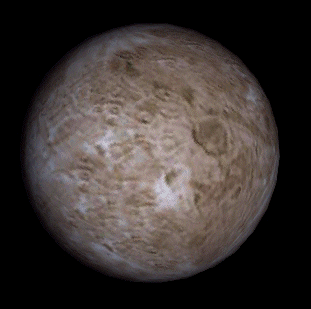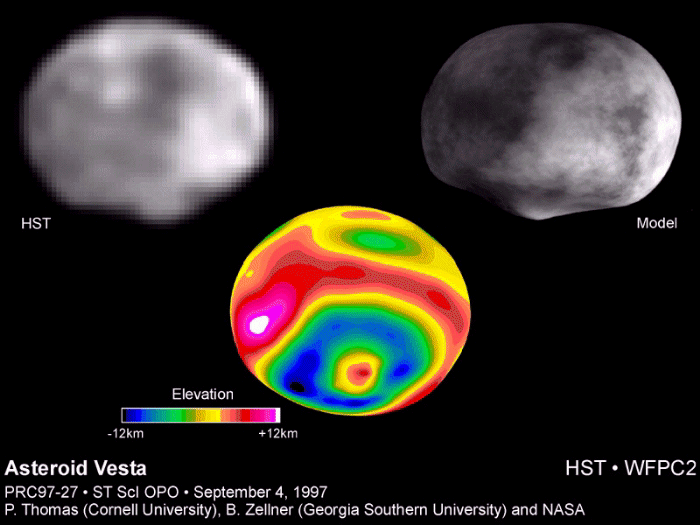
VESTA: THE SIXTH TERRESTRIAL PLANET?

VESTA: THE SIXTH TERRESTRIAL PLANET?
Vesta is the most geologically diverse of the large asteroids and the only known one with distinctive light and dark areas -- much like the face of our Moon. Previous ground-based spectroscopy of Vesta indicates regions that are basaltic, which means lava flows once occurred on its surface. This is surprising evidence that the asteroid once had a molten interior, like Earth does.
One possibility is that Vesta agglomerated from smaller material that includes radioactive debris (such as the the isotope Aluminum-26) that was incorporated into the core. This radioactive "shrapnel" probably came from a nearby supernova explosion. (In fact a supernova might have triggered the birth of our solar system.) This hot isotope may have melted the core, causing the asteroid to differentiate: heavier, dense material sank to the center while lighter rock rose to the surface. This is a common structure for the terrestrial planets. After Vesta's formation, molten rock flowed onto the asteroid's surface. This happened more than four billion years ago. The surface has remained unchanged since then, except for occasional meteoroid impacts.
One or more large impacts tore away some of the crust exposing a deeper mantle of olivine, which is believed to constitute most of the Earth's mantle. Some of the pieces knocked off Vesta have fallen to Earth as meteorites, which show a similar spectral fingerprint to Vesta's surface composition.
A PIECE OF VESTA FALLS TO EARTH
In October 1960, two fence workers in Millbillillie, Western Australia, observed a fireball heading toward the ground, and pieces of the fallen meteorite were found ten years later. The fragments stood out from the area's reddish sandy soil because they had a shiny black fusion crust, produced by their fiery entry through Earth's atmosphere.
Unlike most other meteorites, this sample can be traced to its parent body, the asteroid Vesta. The meteorite's chemical identity points to Vesta because it has the same unique pyroxene spectral signature. Pyroxine is common in lava flows, meaning that the meteorite was created in an ancient lava flow on Vesta's surface. The structure of the meteorite's mineral grains also indicates it was molten and then cooled. The isotopes (oxygen atoms with varying number of neutrons) in the specimen are unlike the isotopes found for all other rocks of the Earth, Moon and most other meteorites.
The meteorite also has the same pyroxene signature as other small asteroids, recently discovered near Vesta, that are considered chips blasted off Vesta's surface. This debris extends all the way to an escape hatch region in the asteroid belt called the Kirkwood gap. This region is swept free of asteroids because Jupiter's gravitational pull removes material from the main belt and hurls it onto a new orbit that crosses Earth's path around the Sun.
The Australian meteorite probably followed this route to Earth. It was torn off Vesta's surface as part of a larger fragment. Other collisions broke apart the parent fragment and threw pieces toward the Kirkwood gap, and onto a collision course toward Earth. Meteorites found in other locations on Earth are probably from Vesta too.
THE OBSERVATION
Ben Zellner (Georgia Southern University), Alex Storrs (Space Telescope Science Institute Baltimore, MD), Ed Wells (Computer Sciences Corporation, Bethesda, MD), Rudi Albrecht (European Southern Observatory in Garching bei Munchen, Germany) and collaborators used Hubble's Wide Field and Planetary Camera 2 (WFPC 2) to collect images of Vesta in four colors of light between November 28 and December 1, 1994. At the time Vesta was 156 million miles (252 million km) from Earth. In late December 1994, when Vesta was 10 million miles (16 million km) closer to Earth than a month earlier, HST's Faint Object Camera made even higher resolution images. These results are complemented by infrared observations made on December 11, by Olivier Hainaut and colleagues with an adaptive- optics camera on the European Southern Observatory's 3.6-meter telescope in Chile. By combining Hubble and ESO observations astronomers will be able to produce a geochemical map of an asteroid's surface.

Back To Asteroid Menu
Use the "BACK" button on your Browser to return to the previous page.